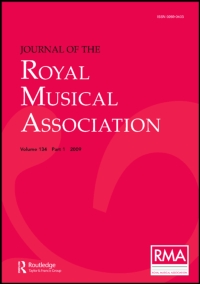No CrossRef data available.
Article contents
Ancient Greek Music
Published online by Cambridge University Press: 01 January 2020
Extract
I have often been asked the question, “How can we know anything about ancient Greek music?” or “How can any fragments of it that may be discovered be translated into modern notation?” The answer is simple enough. Of actual specimens of ancient Greek music, the existing examples may be counted on the fingers of the two hands, but a fairly considerable amount of its theory has come down to us in the works of Aristoxenus of Tarentum (who wrote treatises on harmonics and rhythm), Cleonides, Euclid, Nicomachus, Alypius (who has given us the complete notation), Gaudentius, Bacchius, senior, Aristides, Quintilianus (the anonymous writer), and finally Claudius Ptolemy and Plutarch. These authors flourished at various times, from about 300 B.C. to 200 A.D., the most ancient and the most important being Aristoxenus.
- Type
- Research Article
- Information
- Copyright
- Copyright © Royal Musical Association, 1897
References
∗ The principal editions of these authors are: Meibomius, “Antique Musicæ Auctores Septem.” 1652. Containing the text, with a Latin translation of Aristoxenus, Euclid, Nicomachus, Alypius, Gaudentius, Bacchius, senior, Aristides, Quintilianus. There are two books attributed to Euclid, the first of which has, however, been of late years attributed to Cleonides. J. Wallis, “Claudii Ptolemæi Harmonicorum Libri tres.” 1682. Greek text with Latin translation. In this book are explained the transpositions of the modes and keys. Westphal, “Plutarch, über die Musik.” 1865. Greek text with German translation and notes. F. Bellermann, “Anonymi Scriptio de Musica.” and “Bacchii Senioris introductio.” Berlin. 1841. Greek text with Latin notes. Westphal, “Aristoxenus, Melik und Rhythmik.” Leipzig. 1883 Greek text with German translation and notes. Most of the above works have been translated into French and German, and are easily accessible in this form, though the original editions are out of print and scarce.Google Scholar
∗ The whole of the Greek music at present known to us will be found in the original and in modern notation in Gevaert's “La Musique de l'antiquité.” Vol. I. Ghent. 1873, and “La Melopée antique.” Ghent. 1895.Google Scholar
∗ Prætorius, “Syntagma.” 1618. Vol. II., p. 113. “Allheir lässt sichs anschen, als dass sie zu den Orgeln anfangs nicht mehr als diese eilf claves, darinnen die Alten die drei tetrachorda comprehendirt, genommen haben; als 1. Tetrachordum hypaton, von ♮ quadrato bis ins E. … 2. Tetrachordum meson vom E zum A. 3. Tetrachordum dieneugmenon von ♮ ins e.Google Scholar

† Thus, for example, Gaudentius, p. 11., explains “harmonious” sounds as unisons, consonances, and paraphones. Unisons are when two sounds which do not differ in pitch are struck simultaneously. Consonances are perfect fourths, perfect fifths, and octaves. Paraphones are intermediate between consonances and dissonances, as augmented fourths, major thirds.Google Scholar
‡ See “Dictionary of Greek and Roman Antiquities.” Third edition. Art., “Musica.” Or any recent work on ancient music by, e.g., Chappell, Westphal, Gevaert, &c.Google Scholar
∗ Aristides Quintilianus, p. aa, &c. The twelve equal semitones of Aristoxenus are discussed by Westphal in various places.Google Scholar
† See Claudius Ptolemy. Book II., Chapters 7 and 11.Google Scholar
‡ See Gevaert, “La Musique de l'Antiquité.” Vol. I., Book ii., Chapter 3.Google Scholar
∗ Aristoxenus (Meibom.), pp. 38 and 39.Google Scholar
† Aristoxenus (Meibom.), p. 21.Google Scholar
∗ See Prout's “Musical Form,” p. 15, for other examples.Google Scholar
∗ Aristotle. Problem xix., and elsewhere.Google Scholar
† Aristoxenus, p. 55.Google Scholar
‡ The Delphic and Tralles Hymns show evidences of this construction. See Classical Review, March, 1898.Google Scholar
∗ Aristoxenus, p. 8.Google Scholar
† In “Les Mélodies grégoriennes.” ch. 4. Tonrnay. 1881.Google Scholar
‡ Anonymus, p. 78. Gaudentius, p 23 Aristotle, Problem xix., &c.Google Scholar
§ Plutarch Chapter xiv. Aristotle, Problem xix., 12, &c. Gaudentius, p. 11.Google Scholar
∗ See Gevaert, “La Musique de l'Antiquité.” Vol. I., p. 336.Google Scholar
† Prætoriua' Syntagma, p. 108.Google Scholar
‡ Aristoxenus, p. 16. Gaudentius, p. 4. Bacchius, p. 2 Aristides, p. 15. Anon., p. 30.Google Scholar
∗ Gevaert. Vol. I, p. 364, Note. Vol II., p. 292Google Scholar
∗ For further information on the ancient lyres and flutes see Gevaert, “La Musique de F Antiquité.” Vol. II., Book iv. Chapter 1.Google Scholar
† See “Dictionary of Greek and Roman Antiquities,” sub voce, “Tuba.”Google Scholar


